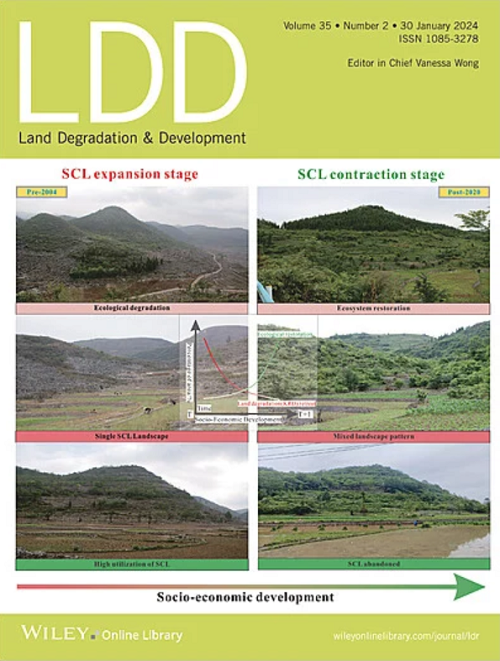Effects of Vegetation and Slope Gradient on Rainfall‐Induced Erosion of Reconstructed Iron Tailings Slopes: An Experimental Study
IF 3.6
2区 农林科学
Q2 ENVIRONMENTAL SCIENCES
引用次数: 0
Abstract
The loose structure and steep slope of iron tailings severely limit vegetation restoration under heavy rainfall erosion. To mitigate soil and water loss from iron tailings, this study reconstructed iron tailings to create a substrate suitable for plant growth. The effects of vegetation at different growth stages and slope gradients on runoff erosion on reconstructed soil slopes were investigated, providing scientific support for optimizing slope stability and vegetation‐based ecological restoration techniques. Continuous monitoring of runoff initiation time, volume, and sediment yield enables quantitative analysis of the effects of these factors on rainfall infiltration and slope erosion. The results revealed that bare soil slopes presented average infiltration rates of 0.916, 0.891, and 0.857 mm/min, which stabilized within 9 to 12 min, with rates decreasing as the slope gradient increased. In contrast, vegetation significantly enhances infiltration; for example, on a 15° slope, the average infiltration rates for vegetated slopes at 30, 60, and 90 days were 0.923, 0.936, and 0.943 mm/min, stabilizing at 15, 24, and 27 min, respectively. Furthermore, vegetation cover effectively reduces runoff rates, with the cumulative runoff volume decreasing by 13%, 40%, and 53.2% at 30, 60, and 90 days, respectively. Vegetation also substantially suppresses soil erosion, with sediment yield reductions ranging from 12.5% to 76.56%, 11.77% to 77.57%, and 11.97% to 78.66% across various slopes. After 60 days of growth, significant improvements in runoff and erosion control were observed, providing crucial insights for soil stabilization and the advancement of vegetation‐based slope protection technologies.植被和坡度对铁尾矿坡面降雨侵蚀影响的试验研究
铁尾矿结构松散,坡度陡,严重限制了强降雨侵蚀下植被的恢复。为了减轻铁尾矿的水土流失,本研究对铁尾矿进行了改造,创造了适合植物生长的基质。研究了不同生长阶段和坡度下植被对重建土壤坡面径流侵蚀的影响,为优化坡面稳定性和基于植被的生态修复技术提供科学支持。连续监测径流起始时间、体积和产沙量,可以定量分析这些因素对降雨入渗和坡面侵蚀的影响。结果表明:裸地坡面平均入渗速率分别为0.916、0.891和0.857 mm/min,在9 ~ 12 min内保持稳定,随坡度增加入渗速率逐渐降低;植被对入渗有显著促进作用;以15°坡面为例,植被覆盖坡面30、60和90 d的平均入渗速率分别为0.923、0.936和0.943 mm/min,在15、24和27 min稳定。植被覆盖有效地降低了径流速率,在30、60和90 d时,累计径流量分别减少了13%、40%和53.2%。植被对土壤侵蚀也有明显的抑制作用,各坡面产沙量分别减少12.5% ~ 76.56%、11.77% ~ 77.57%和11.97% ~ 78.66%。经过60天的生长,我们观察到径流和侵蚀控制的显著改善,为土壤稳定和基于植被的护坡技术的进步提供了重要的见解。
本文章由计算机程序翻译,如有差异,请以英文原文为准。
求助全文
约1分钟内获得全文
求助全文
来源期刊

Land Degradation & Development
农林科学-环境科学
CiteScore
7.70
自引率
8.50%
发文量
379
审稿时长
5.5 months
期刊介绍:
Land Degradation & Development is an international journal which seeks to promote rational study of the recognition, monitoring, control and rehabilitation of degradation in terrestrial environments. The journal focuses on:
- what land degradation is;
- what causes land degradation;
- the impacts of land degradation
- the scale of land degradation;
- the history, current status or future trends of land degradation;
- avoidance, mitigation and control of land degradation;
- remedial actions to rehabilitate or restore degraded land;
- sustainable land management.
 求助内容:
求助内容: 应助结果提醒方式:
应助结果提醒方式:


